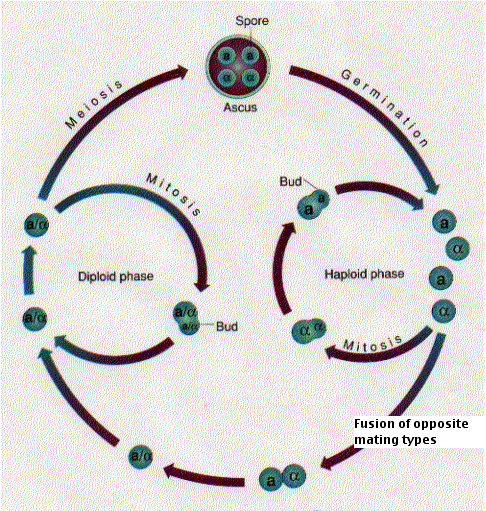

Figure
1
He was a wise man who invented beer
~ Plato ~
Saccharomyces cerevisiae, also known as bakers or brewers yeast, is a very important fungi, which has been used since prehistoric times to make bread, wine, and beer (1). More recently S. cerevisiae has been used as a scientific model organism, and is the most understood eukaryotic cell. It has lead to both good and bad things for humans, like many full stomachs, scientific studies and hangovers. Its full classification name can be found in Table 1.
S. cerevisiae is a microorganism that is classified as an Ascomycete. Which means that during sexual-reproduction, a sac-like structure called the ascus is formed (2). During mitosis it can reproduce forming buds, which is why it is called a budding yeast (6). The full reproductive cycle for yeast can be seen in Figure 2. S. cerevisiae can be found in both aquatic and terrestrial environments, usually ones that contain a lot of soluble nutrients like sugars (3). Temperatures that the fungi can survive and grow in range from a minimum of 1-3°C to a maximum of 40°C, with an optimum temperature of 28°C (2).
S. cerevisiae is a heterochemoorganotroph because it has to find its own food (reduced organic products). The conversion of the food they eat is beneficial to humans. The conversion of sugars creates products like alcohol and carbon dioxide. The process of making beer and wine are the result of anaerobic processes, while the making of bread is an aerobic process(4). The interesting thing is that even in the presence of oxygen, S. cerevisiae undergoes fermentation, which is why when someone makes bread it rises, due to the formation of carbon dioxide. It is very interesting to note that even in the presence of a better electron acceptor, yeast still undergo fermentation.
Yeast + Sugars => Alcohol + CO2
One interesting journal article entitled “Induction of apoptosis in breast cancer cells by Saccharomyces cerevisiae, the baker’s yeast, in vitro” studied the effects of phagocytosis of killed yeast on the induction of apoptosis in human metastatic breast cancer cells. In the study heat-killed yeast were cultured alongside cancer cells and the cancer cells engulfed the yeast cells. It was found that the breast cells underwent apoptosis, and that metastatic cancer cells were more susceptible to apoptosis than other cells. This might have medicinal or clinical applications and one day might help fight breast cancer. This is just another example of why S. cerevisiae is so important to our world.
While finding the information for this project, it was quite interesting to see that after using the yeast for brewing beer, the yeast was often made into a powder and sold as a supplement. Most of the sites stated that the powdered yeast was a high source of vitamin B, and also chromium, which has medicinal values and can help reduce insulin levels and fight diabetes (5). So, what's in a name? In conclusion, Saccharomyces cerevisiae has a very interesting name, which roughly translates into sugar mold or beer.
Do
you want your own Saccharomyces cerevisiae to take
home and hug every night? Well here's a special site for you!!!
http://www.giantmicrobes.com/exotics/beerandbread.html
 |
|
Figure 2
|
Table 1. Classification of Saccharomyces cerevisiae |
|||
| Kingdom | Fungi | ||
| Phylum | Ascomycota | ||
| Subphylum | Saccharomycotina | ||
| Class | Saccharomycetes | ||
| Order | Saccharomycetales | ||
| Family | Saccharomycetaceae | ||
| Genus | Saccharomyces | ||
| Species | cerevisiae | ||
In order
to have a better understanding for where yeast fit into the big
picture, check out this
universal
phylogenetic tree.
Furthermore, it was previously stated that Saccharomyces cerevisiae has been used as a model organism to study a variety of complex cellular dynamics. Below is a movie that shows how some of these complex systems within a cell work together. An appreciation for why these systems have to be studied on simpler organisms such as yeast will become evident. Movie was created by XVIVO called The Inner Life of the Cell for Harvard cellular and molecular biology students.